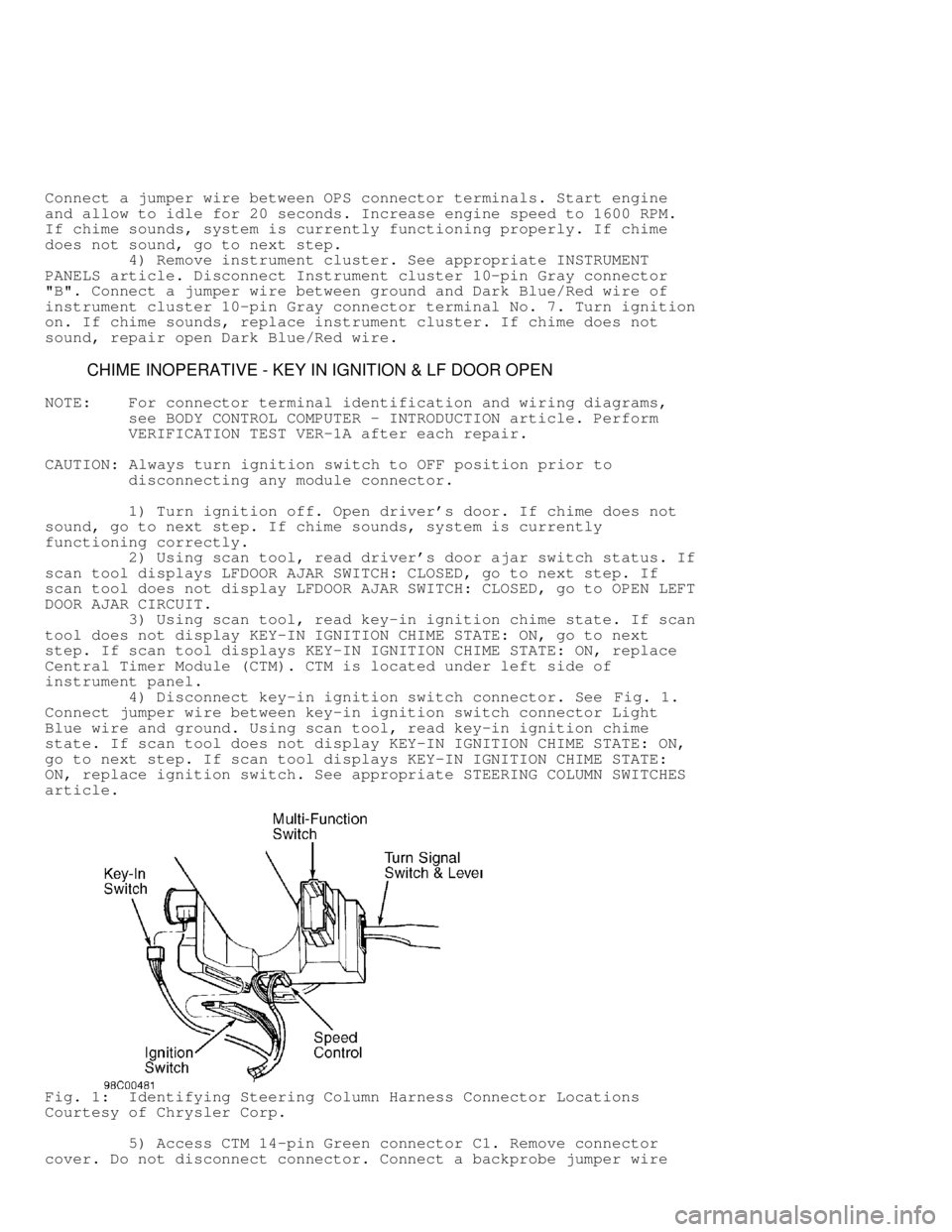1999 DODGE RAM Ignition
[x] Cancel search: IgnitionPage 299 of 1691

Connect a jumper wire between OPS connector terminals. Start engine
and allow to idle for 20 seconds. Increase engine speed to 1600 RPM.
If chime sounds, system is currently functioning properly. If chime
does not sound, go to next step.
4) Remove instrument cluster. See appropriate INSTRUMENT
PANELS article. Disconnect Instrument cluster 10-pin Gray connector
"B". Connect a jumper wire between ground and Dark Blue/Red wire of
instrument cluster 10-pin Gray connector terminal No. 7. Turn ignition
on. If chime sounds, replace instrument cluster. If chime does not
sound, repair open Dark Blue/Red wire.
CHIME INOPERATIVE - KEY IN IGNITION & LF DOOR OPEN
NOTE: For connector terminal identification and wiring diagrams,
see BODY CONTROL COMPUTER - INTRODUCTION article. Perform
VERIFICATION TEST VER-1A after each repair.
CAUTION: Always turn ignition switch to OFF position prior to
disconnecting any module connector.
1) Turn ignition off. Open driver's door. If chime does not
sound, go to next step. If chime sounds, system is currently
functioning correctly.
2) Using scan tool, read driver's door ajar switch status. If
scan tool displays LFDOOR AJAR SWITCH: CLOSED, go to next step. If
scan tool does not display LFDOOR AJAR SWITCH: CLOSED, go to OPEN LEFT
DOOR AJAR CIRCUIT.
3) Using scan tool, read key-in ignition chime state. If scan
tool does not display KEY-IN IGNITION CHIME STATE: ON, go to next
step. If scan tool displays KEY-IN IGNITION CHIME STATE: ON, replace
Central Timer Module (CTM). CTM is located under left side of
instrument panel.
4) Disconnect key-in ignition switch connector. See Fig. 1.
Connect jumper wire between key-in ignition switch connector Light
Blue wire and ground. Using scan tool, read key-in ignition chime
state. If scan tool does not display KEY-IN IGNITION CHIME STATE: ON,
go to next step. If scan tool displays KEY-IN IGNITION CHIME STATE:
ON, replace ignition switch. See appropriate STEERING COLUMN SWITCHES
article.
Fig. 1: Identifying Steering Column Harness Connector Locations
Courtesy of Chrysler Corp.
5) Access CTM 14-pin Green connector C1. Remove connector
cover. Do not disconnect connector. Connect a backprobe jumper wire
Page 300 of 1691

between terminal No. 9 (Light Blue wire) and chassis ground. Using
scan tool, read key-in ignition switch status. If scan tool does not
display KEY-IN IGNITION CHIME STATE: ON, replace CTM. If scan tool
displays KEY-IN IGNITION CHIME STATE: ON, repair open Light Blue wire
between CTM and ignition switch.
CHIME INOPERATIVE AT ALL TIMES
NOTE: Perform VERIFICATION TEST VER-1A after each repair.
Turn ignition on. Using scan tool, select BODY SYSTEM, BODY
COMPUTER then ACTUATORS. Actuate chime. If chime sounds, system is
currently functioning correctly. If chime does not sound, replace
Central Timer Module (CTM). CTM is located under left side of
instrument panel.
CHIME INOPERATIVE WITH EXTERIOR LIGHTS ON
NOTE: For connector terminal identification and wiring diagrams,
see BODY CONTROL COMPUTER - INTRODUCTION article. Perform
VERIFICATION TEST VER-1A after each repair.
CAUTION: Always turn ignition switch to OFF position prior to
disconnecting any module connector.
1) Remove ignition key. Using scan tool, read key-in ignition
chime state. If scan tool does not display KEY-IN IGNITION CHIME
STATE:
OFF, go to step 4). If scan tool displays KEY-IN IGNITION CHIME STATE:
OFF, go to next step.
2) Open driver's door. Using scan tool, read door ajar
status. If scan tool displays LFDOOR AJAR SWITCH: CLOSED, go to next
step. If scan tool does not display LFDOOR AJAR SWITCH: CLOSED, go to
OPEN LEFT DOOR AJAR CIRCUIT.
3) Turn on headlights. If chime does not sound, repair open
headlight sense circuit (Light Blue wire) between CTM and headlight
switch. See appropriate wiring diagram in BODY CONTROL COMPUTER -
INTRODUCTION article. If chime sounds, system is currently functioning
correctly.
4) Open driver's door. Using scan tool, read door ajar
status. If scan tool displays LFDOOR AJAR SWITCH: CLOSED, go to next
step. If scan tool does not display LFDOOR AJAR SWITCH: CLOSED, go to
OPEN LEFT DOOR AJAR CIRCUIT.
5) Disconnect key-in ignition switch connector. See Fig. 1.
Using scan tool, read key-in ignition chime state. If scan tool
displays KEY-IN IGNITION CHIME STATE: ON, go to next step. If scan
tool does not display KEY-IN IGNITION CHIME STATE: ON, replace
ignition switch. See appropriate STEERING COLUMN SWITCHES article.
6) Turn ignition off. Disconnect Central Timer Module (CTM).\
CTM is located under left side of instrument panel. Remove ignition
key. Ensure all lights and accessories are off. Close all doors. Using
external ohmmeter, measure resistance between ground and terminal No.
9 (Light Blue wire) on CTM Green connector "A". If resistance is less
than 10 ohms, repair Light Blue wire between CTM and ignition switch
for short to ground. If resistance is 10 ohms or more, replace CTM.
CHIME INOPERATIVE WITH LOW OIL PRESSURE
NOTE: For connector terminal identification and wiring diagrams,
see BODY CONTROL COMPUTER - INTRODUCTION article. Perform
VERIFICATION TEST VER-1A after each repair.
CAUTION: Always turn ignition switch to OFF position prior to
Page 301 of 1691

disconnecting any module connector.
1) Disconnect Oil Pressure Switch (OPS). OPS is located near\
bottom of distributor. Connect a jumper wire between OPS connector
terminals. Start engine and allow to idle for 20 seconds. Increase
engine speed to 1600 RPM. If chime sounds, go to next step. If chime
does not sound, go to step 3).
2) Turn ignition on. Using scan tool, actuate chime. If chime
does not sound, replace Central Timer Module (CTM). CTM is located
under left side of instrument panel. If chime sounds, system is
currently functioning properly.
3) Using scan tool, access CLUSTER MONITOR. With engine
running, read CCD oil pressure. If scan tool reading does not match
instrument cluster reading, replace instrument cluster. If scan tool
reading matches instrument cluster reading, go to next step.
4) Remove jumper wire. Connect a jumper wire between ground
and OPS connector Gray wire. Start engine and allow to idle for 20
seconds. Increase engine speed to 1600 RPM. If chime sounds, repair
open ground circuit between OPS connector and ground. If chime does
not sound, go to next step.
5) Turn ignition on. Using scan tool, actuate chime. If chime
does not sound, replace Central Timer Module (CTM). CTM is located
under left side of instrument panel. If chime sounds, go to next step.
6) Remove instrument cluster. See appropriate INSTRUMENT
PANELS article. Disconnect CTM 14-pin Green connector C1. Using an
external ohmmeter, measure resistance of Dark Blue/Red wire between
CTM 14-pin Green connector C1 terminal No. 2 and instrument cluster
10-pin connector C2 terminal No. 7. If resistance is less than 5 ohms,
replace CTM. If resistance is 5 ohms or more, repair open Dark
Blue/Red wire.
CHIME SOUNDS WITH DRIVER DOOR OPEN
NOTE: For connector terminal identification and wiring diagrams,
see BODY CONTROL COMPUTER - INTRODUCTION article. Perform
VERIFICATION TEST VER-1A after each repair.
CAUTION: Always turn ignition switch to OFF position prior to
disconnecting any module connector.
1) Ensure all interior and exterior lights are off. Remove
ignition key and open driver's door. If chime does not sound, system
is currently functioning correctly. If chime sounds, go to next step.
2) Using scan tool, read key-in ignition chime state. If scan
tool displays KEY-IN IGNITION CHIME STATE: "ON/OFF", go to next step.
If scan tool does not display KEY-IN IGNITION CHIME STATE: "ON/OFF",
replace Central Timer Module (CTM). CTM is located under left side of
instrument panel.
3) Disconnect key-in ignition switch connector. See Fig. 1.
Using scan tool, read key-in ignition chime state. If scan tool
displays KEY-IN IGNITION CHIME STATE: ON, go to next step. If scan
tool does not display KEY-IN IGNITION CHIME STATE: ON, replace
ignition switch. See appropriate STEERING COLUMN SWITCHES article.
4) Turn ignition off. Disconnect Central Timer Module (CTM).\
CTM is located under left side of instrument panel. Remove ignition
key. Ensure all lights and accessories are off. Close all doors. Using
external ohmmeter, measure resistance between ground and terminal No.
9 (Light Blue wire) on CTM Green connector "A". If resistance is less
than 10 ohms, repair Light Blue wire between CTM and ignition switch
for short to ground. If resistance is 10 ohms or more, replace CTM.
DOOR AJAR SYSTEM
Page 302 of 1691

OPEN LEFT DOOR AJAR CIRCUIT
NOTE: For connector terminal identification and wiring diagrams,
see BODY CONTROL COMPUTER - INTRODUCTION article. Perform
VERIFICATION TEST VER-1A after each repair.
CAUTION: Always turn ignition switch to OFF position prior to
disconnecting any module connector.
1) Remove driver's door panel. Disconnect driver's door ajar
switch and ensure connector is clean and not damaged. Connect a jumper
wire between left front door ajar switch connector Tan wire and
Black/Light Green wire. Using scan tool, read left front door ajar
switch status. If scan tool displays DRDOOR AJAR SW: CLOSED, replace
left front door ajar switch. If scan tool does not display DRDOOR AJAR
SW:
CLOSED, go to next step.
2) Disconnect jumper wire from Black/Light Green wire. Take
jumper wire end removed from Black/Light Green wire and connect to
ground. If scan tool displays DRDOOR AJAR SW: CLOSED, repair open
ground circuit (Black/Light Green wire). If scan tool does not display\
DRDOOR AJAR SW: CLOSED, go to next step.
3) Disconnect jumper wire. Locate Central Timer Module (CTM)\
.
CTM is located under left side of instrument panel. Access CTM 14-pin
Green connector C1. Remove connector cover. Do not disconnect
connector. Connect a backprobe jumper wire between chassis ground and
terminal No. 1 (Tan wire). Using scan tool, read left front door ajar
switch status. If scan tool displays DRDOOR AJAR SW: CLOSED, repair
open in Tan wire between left front door ajar switch and CTM. If scan
tool does not display DRDOOR AJAR SW: CLOSED, replace CTM.
OPEN RIGHT DOOR AJAR CIRCUIT
NOTE: For connector terminal identification and wiring diagrams,
see BODY CONTROL COMPUTER - INTRODUCTION article. Perform
VERIFICATION TEST VER-1A after each repair.
CAUTION: Always turn ignition switch to OFF position prior to
disconnecting any module connector.
1) Remove passenger's door panel. Disconnect right front door
ajar switch and ensure connector is clean and not damaged. Connect a
jumper wire between right front door ajar switch connector Black/Light
Blue wire and Black/Light Green wire. Using scan tool, read right
front door ajar switch status. If scan tool displays PASSDOOR AJAR SW:
CLOSED, replace right front door ajar switch. If scan tool does not
display PASSDOOR AJAR SW: CLOSED, go to next step.
2) Disconnect jumper from Black/Light Green wire. Take jumper
wire end removed from Black/Light Green wire and connect to ground. If
scan tool displays PASSDOOR AJAR SWITCH: CLOSED, repair open ground
circuit (Black/Light Green wire). If scan tool does not display
PASSDOOR AJAR SW: CLOSED, go to next step.
3) Disconnect jumper wire. Locate Central Timer Module (CTM)\
.
CTM is located under left side of instrument panel. Access CTM 14-pin
Green connector C1. Remove connector cover. Do not disconnect
connector. Connect a backprobe jumper wire between chassis ground and
terminal No. 5 (Black/Light Blue wire). If scan tool displays PASS
DOOR AJAR SW: CLOSED, repair open Black/Light Blue wire between CTM
and right front door ajar switch. If scan tool does not display PASS
DOOR AJAR SW: CLOSED, replace CTM.
SHORTED LEFT DOOR AJAR CIRCUIT
Page 303 of 1691

NOTE: For connector terminal identification and wiring diagrams,
see BODY CONTROL COMPUTER - INTRODUCTION article. Perform
VERIFICATION TEST VER-1A after each repair.
CAUTION: Always turn ignition switch to OFF position prior to
disconnecting any module connector.
1) Remove driver's door panel. Disconnect driver's door ajar
switch. Using scan tool, read left front door ajar switch status. If
scan tool displays DRDOOR AJAR SW: CLOSED, go to next step. If scan
tool does not display DRDOOR AJAR SW: CLOSED, replace left front door
ajar switch.
2) Disconnect Central Timer Module (CTM) 14-pin Green
connector C1. CTM is located under left side of instrument panel.
Using an external ohmmeter, measure resistance between ground and CTM
14-pin Green connector C1 terminal No. 1 (Tan wire). If resistance is
less than 5 ohms, repair short to ground in Tan wire between CTM 14-
pin connector C1 and left front door ajar switch. If resistance is 5
ohms or more, replace CTM.
SHORTED RIGHT DOOR AJAR CIRCUIT
NOTE: For connector terminal identification and wiring diagrams,
see BODY CONTROL COMPUTER - INTRODUCTION article. Perform
VERIFICATION TEST VER-1A after each repair.
CAUTION: Always turn ignition switch to OFF position prior to
disconnecting any module connector.
1) Ensure all doors are closed. Open right front door and
remove door panel. Disconnect right front door ajar switch. Using scan
tool, read right front door ajar switch status. If scan tool displays
PASSDOOR AJAR SW: CLOSED, go to next step. If scan tool does not
display PASSDOOR AJAR SW: CLOSED, replace right front door ajar
switch.
2) Disconnect Central Timer Module (CTM) 14-pin Green
connector C1. CTM is located under left side of instrument panel.
Using an external ohmmeter, measure resistance between ground and CTM
14-pin Green connector C1 terminal No. 5 (Black/Light Blue wire). If
resistance is less than 5 ohms, repair short to ground in Black/Light
Blue wire. If resistance is 5 ohms or more, replace CTM.
INSTRUMENT CLUSTER
ALL GAUGES DO NOT OPERATE
NOTE: For connector terminal identification and wiring diagrams,
see BODY CONTROL COMPUTER - INTRODUCTION article. Perform
VERIFICATION TEST VER-1A after each repair.
CAUTION: Always turn ignition switch to OFF position prior to
disconnecting or connecting any module connector.
1) Turn ignition on. Using scan tool, select ELECTRO/MECH
CLUSTER. If scan tool displays BUS OPERATIONAL, go to next step. If
scan tool does not display BUS OPERATIONAL, go to appropriate VEHICLE
COMMUNICATIONS article and follow appropriate symptom diagnostics.
2) If scan tool displays NO RESPONSE, go to appropriate
VEHICLE COMMUNICATIONS article. If scan tool does not display NO
RESPONSE, go to next step.
3) Using scan tool, select SYSTEM TEST. If scan tool displays
Page 304 of 1691

PCM INACTIVE ON BUS, go to appropriate VEHICLE COMMUNICATIONS article.
If scan tool does not display PCM INACTIVE ON BUS, go to next step.
4) Turn ignition off. Remove instrument cluster. See
appropriate INSTRUMENT PANELS article. Turn ignition on. Using
external voltmeter, measure voltage between ground and instrument
cluster connector C1 terminal No. 6 (Yellow wire). If voltage is 10
volts or less, repair open Yellow wire. If voltage is more than 10
volts, replace instrument cluster.
ANY CCD CLUSTER LIGHT INOPERATIVE
NOTE: For connector terminal identification and wiring diagrams,
see BODY CONTROL COMPUTER - INTRODUCTION article. Perform
VERIFICATION TEST VER-1A after each repair.
CAUTION: Always turn ignition switch to OFF position prior to
disconnecting or connecting any module connector.
1) Turn ignition on. Using scan tool, select ELECTRO/MECH
CLUSTER. If scan tool displays BUS OPERATIONAL, go to next step. If
scan tool does not display BUS OPERATIONAL, go to appropriate VEHICLE
COMMUNICATIONS article and follow appropriate symptom diagnostics.
2) If scan tool displays NO RESPONSE, go to appropriate
VEHICLE COMMUNICATIONS article. If scan tool does not display NO
RESPONSE, go to next step.
3) Using scan tool, select SYSTEM TEST. If scan tool displays
PCM INACTIVE ON BUS, go to appropriate VEHICLE COMMUNICATIONS article.
If scan tool does not display PCM INACTIVE ON BUS, go to next step.
4) Push and hold RESET button while cycling ignition key.
Release RESET button when CHEC appears in odometer display. Observe
inoperative light during self-test. If inoperative light did not
illuminate during self-test, go to next step. If inoperative light
illuminated during self-test, verify if light is controlled by an
input to instrument cluster. See appropriate wiring diagram in BODY
CONTROL COMPUTER - INTRODUCTION article. If light is controlled by an
input to instrument cluster, go to appropriate circuits article or
symptom test. See IDENTIFYING VEHICLE EQUIPMENT & SYSTEM PROBLEMS. If
light is not controlled by an input to instrument cluster, system is
currently functioning correctly.
5) Gain access to instrument cluster. See appropriate
INSTRUMENT PANELS article. If defective light is a LED, replace
instrument cluster. If defective light is a bulb, go to next step.
6) Remove and inspect defective bulb. If bulb is burned out,
replace bulb. If bulb is not burned out, replace instrument cluster.
ANY HARD WIRED CLUSTER WARNING LIGHT INOPERATIVE
NOTE: For connector terminal identification and wiring diagrams,
see BODY CONTROL COMPUTER - INTRODUCTION article. Perform
VERIFICATION TEST VER-1A after each repair.
CAUTION: Always turn ignition switch to OFF position prior to
disconnecting or connecting any module connector.
1) Remove instrument cluster. See appropriate INSTRUMENT
PANELS article. Remove inoperative bulb. If bulb is burned out,
replace bulb. If bulb is not burned out, go to next step.
2) Inspect wiring diagram and evaluate which instrument
cluster provides; power or ground for inoperative bulb. See
appropriate wiring diagram in BODY CONTROL COMPUTER - INTRODUCTION
article. Using external ohmmeter or voltmeter, check appropriate power
or ground circuit. If circuit is okay, replace instrument cluster. If
power or ground is not available at appropriate circuit, repair open
Page 305 of 1691

circuit.
ONE GAUGE NOT OPERATING PROPERLY
NOTE: For connector terminal identification and wiring diagrams,
see BODY CONTROL COMPUTER - INTRODUCTION article. Perform
VERIFICATION TEST VER-1A after each repair.
CAUTION: Always turn ignition switch to OFF position prior to
disconnecting or connecting any module connector.
1) Push and hold RESET button while cycling ignition key; ON-
OFF-ON. Instrument cluster self-test will start. If inoperative gauge
reached proper calibration point, go to next step. If inoperative
gauge did not reach proper calibration point, replace instrument
cluster.
2) Stop instrument cluster self-test. If problem is with
speedometer, go to next step. If problem is with oil pressure gauge,
go to step 5). If problem is with temperature gauge, go to step 14).
If problem is with fuel level gauge, go to appropriate SELF-
DIAGNOSTICS article in ENGINE PERFORMANCE section and review
powertrain symptoms. If problem is with volt gauge, go to step 16). If
problem is with tachometer, go to step 18).
3) Using scan tool, select BODY, SYSTEMS TESTS then PCM
MONITOR. If scan tool displays PCM ACTIVE ON BUS, go to next step. If
scan tool does not display PCM ACTIVE ON BUS, go to appropriate
VEHICLE COMMUNICATIONS article.
4) Raise and support all wheels. Start engine and place gear
selector in drive. Using scan tool, select MIC, MONITORS then CCD BUS
ENGINE INFO. Read VSS. If vehicle speed on scan tool matches
speedometer, see appropriate ANTI-LOCK BRAKE article. If vehicle speed
on scan tool does not match speedometer, replace instrument cluster
circuit board.
5) Turn ignition on. If CHECK GAUGES light illuminated, go to
next step. If CHECK GAUGES light did not illuminate, go to step 11).
6) Turn ignition off. Inspect oil level. If oil level is
within specification, go to next step. If oil level is not within
specification, adjust oil level and retest.
7) Turn ignition on. Disconnect engine Oil Pressure Switch
(OPS) connector. OPS is located near bottom of distributor. If CHECK
GAUGES light went out, go to next step. If CHECK GAUGES light did not
go out, go to step 10).
8) Remove OPS. Connect mechanical oil pressure gauge to OPS
port. Start engine. If engine oil pressure at idle is 4 psi or more,
go to next step. If engine oil pressure at idle is less than 4 psi,
repair mechanical engine problem.
9) Run engine to reach normal operating temperature. If
engine oil pressure at idle is 4 psi or more, replace OPS. If engine
oil pressure at idle is less than 4 psi, repair mechanical engine
problem.
10) Turn ignition off. Disconnect PCM White connector C2. PCM
is located in engine compartment on right inner fender. Using an
external ohmmeter, measure resistance between ground and PCM Black
connector terminal No. 23 (Gray/Orange wire). If resistance is less
than 5 ohms, repair short to ground in Gray/Orange wire. If resistance
is 5 ohms or more, replace PCM.
11) Disconnect engine Oil Pressure Switch (OPS) connector.
OPS is located near bottom of distributor. Using an external ohmmeter,
measure resistance between ground and OPS connector Black/Light Blue
wire. If resistance is less than 5 ohms, go to next step. If
resistance is 5 ohms or more, repair open Black/Light Blue wire.
Black/Light Blue wire is a common sensor ground. If no other engine
sensors are failed, repair ground between sensor and splice. If
Page 307 of 1691

NOTE: For connector terminal identification and wiring diagrams,
see BODY CONTROL COMPUTER - INTRODUCTION article. Perform
VERIFICATION TEST VER-1A after each repair.
If temperature reading is off by more than 5
�F, ambient
temperature sensor is defective. Replace ambient temperature sensor.
Ambient temperature sensor is located on left radiator saddle.
REPAIRING "OC" IN CMTC DISPLAY
NOTE: For connector terminal identification and wiring diagrams,
see BODY CONTROL COMPUTER - INTRODUCTION article. Drive
vehicle at least 3 miles (greater than 25 MPH) to update CMTC\
and perform VERIFICATION TEST VER-1A after each repair.
CAUTION: Always turn ignition switch to OFF position prior to
disconnecting any module connector.
1) Disconnect ambient temperature sensor connector. Sensor is
located on left radiator saddle. Connect jumper wire between sensor
connector terminals. Turn ignition on. Observe CMTC display. If CMTC
displays SC, replace ambient temperature sensor. If CMTC does not
display SC, go to next step.
2) Turn ignition off. Disconnect jumper wire. Disconnect CMTC
module connector. Connect a jumper wire between ground and ambient
temperature sensor harness connector Violet/Light Green wire. If CMTC
displays SC, repair open Black/Violet wire between ambient temperature
sensor harness connector and ground. If CMTC does not display SC, go
to next step.
3) Connect a backprobe jumper wire between ground and CMTC
harness connector terminal No. 3 (Violet/Light Green wire). If CMTC
displays SC, repair open Violet/Light Green wire between ambient
temperature sensor harness connector and CMTC connector. If CMTC does
not display SC, replace CMTC module.
REPAIRING "SC" IN CMTC DISPLAY
NOTE: For connector terminal identification and wiring diagrams,
see BODY CONTROL COMPUTER - INTRODUCTION article. Perform
VERIFICATION TEST VER-1A after each repair.
CAUTION: Always turn ignition switch to OFF position prior to
disconnecting any module connector.
1) Turn ignition off. Disconnect CMTC connector. Using an
external ohmmeter, measure resistance between CMTC harness connector
terminal No. 3 (Violet/Light Green wire) and terminal No. 7
(Black/Light Green wire). If resistance is less than 5 ohms, repair
Violet/Light Green wire between CMTC module and ambient temperature
sensor for short to ground. If resistance is 5 ohms or more, go to
next step.
2) Measure resistance between CMTC harness connector terminal
No. 9 (Black/Light Blue wire) and terminal No. 3 (Violet/Light Green
wire). If resistance is less than 1000 ohms, repair Violet/Light Green
wire for short to Black/Light Blue wire. If resistance is 1000 ohms or
more, go to next step.
3) Disconnect ambient temperature sensor connector. Sensor is
located on left radiator saddle. Observe CMTC display. If CMTC
displays OC, replace ambient temperature sensor. If CMTC does not
display OC, replace CMTC module.